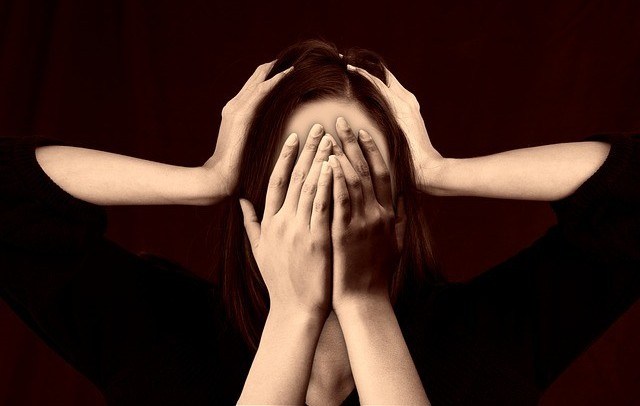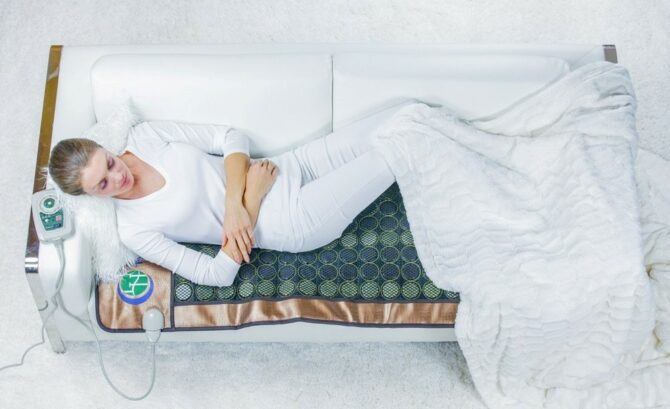The migraine, disease that affects 1 billion people worldwide, is the 6th most disabling chronic disease, according to the World Health Organization (WHO).
In this article, we will dig into migraine headache symptoms and triggers. Before that, it’s worth exploring more on what exactly migraine is.
What is Migraine Headache?
Migraine is one of the types of headaches. Migraine is a pulsating or throbbing pain on one side of the head (sometimes both), often accompanied by nausea and extreme sensitivity of photophobia (lights) and phonophobia (noise). The duration of the migraine ranges from four to 72 hours and maybe less in children. From the world population, 5 to 25% of women and 2 to 10% of men have migraines. Migraine is predominant in people aged from 25 to 45 years, and following the 50th birthday this percentage tends to decrease, especially in women. The disease occurs in 3 to 10% of children, affecting both genders equally before puberty, but mostly in females after this phase. Let’s learn more about what causes migraines.Causes for Migraine Headaches
The exact cause for migraines is unknown, although they are known to be related to brain changes and have a genetic influence. A migraine begins when nerve cells, already in a state of hyperexcitability, react to some often-external trigger, sending nerve impulses to the blood vessels, causing their constriction (aura-related) followed by dilation (expansion of blood vessels) and the release of prostaglandins, serotonin, and other inflammatory substances that cause pain. In general, for each individual the crisis pattern is the same, it can vary but only in intensity. The spacing between seizures is also usually variable. It is also known that the trigger for migraine attacks vary from individual to individual, and some people may not have any specific triggers.What You Should Know About Migraine
1. Migraine headaches occur due to change in blood pressure in vessels of the brain and its surroundings. It is one of the most commonly seen problems in hospital doctors’ offices. 2. You can use home remedies for relief of migraine pain at first, over-the-counter drugs can benefit as well, but prescription medications from the doctor can prevent your migraine pain better. Tip: Don’t confuse with Natural Remedies for Chronic Back Pain though. 3. If your migraine pattern changes frequently, it keeps becoming severe, or unusual ‘headaches’ than what you experience usually, then you need to take this condition more seriously and seek medical advice.Migraine Headache Types and Symptoms
There are different types of migraine, and the symptoms may vary according to the type of migraine. We will discuss the different types of migraines and their symptoms below.- Pre-migraine/The prodromal
- Aura migraine
- Silent migraine
- Eye migraine
- Atypical migraine
- Complicated migraine
Pre-migraine | The Prodrome
What is Pre-migraine or the Prodromal Migraine?
Pre-migraine symptoms occur in the first stage of migraine, which is known as the prodromal stage, and the early symptoms will start occurring 24 hours before any headache.Prodrome Migraine Symptoms
Those signs and symptoms might include below.- Constipation
- Diarrhea
- Difficulty in concentrating
- Uncontrollable yawning
- Depression or Euphoria
- Neck stiffness
- Restlessness
- Fatigue (e.g. Chronic Fatigue Syndrome)
Aura Migraine
What is Aura Migraine?
Aura migraine is also known as the visual aura, which can present as flashes of light, dark mosaic-like spots or bright zigzag images – like when you’re walking on a road and seeing that heat zigzag emanating from the ground. In other cases, migraine with aura may manifest as numbness or tingling on one side of the body – depending on the severity of migraine with aura, one may begin with a tingling in one hand, and it may spread all over the side of the body. Body, falling asleep to only half of the tongue. However, these sensitive manifestations of migraine with aura are rarer. Generally, the aura begins from headache in the migraine attack and may or may not persist after the pain begins.Aura Migraine Symptoms
The most common symptoms in aura migraine are:- Presence of bright images or light streaks in vision.
- Loss of part of the visual field (double vision).
- Luminous flashes
- Blurred vision
Silent Migraine
What is Silent Migraine?
A silent migraine is a migraine without a headache; however, a silent migraine can still be unbearable sometimes.Silent Migraine Symptoms
The symptoms of silent migraine may include all the symptoms of aura migraine except headache, the other symptoms may include the below.- Speech problems might occur
- Mood swings
- Hearing loss
- Memory lapses
- Gastric problems and mental confusions
- Numbness
Ocular Migraine (or Eye Migraine)
What is Ocular Migraines?
Ocular migraine can be very painful as it is directly concerned with an eye. It can be excruciating and disabling. About 25-30% of people with migraines in the U.S. experience aura, but less than 20% of them experience it with the everyday episode. Commonly a migraine without aura is usually called ocular or eye migraine.Eye Migraine Symptoms
The symptoms of an ocular migraine include:- Nausea and vomiting
- Severe pain, which can cause throbbing or pulsating, usually in one or both sides of the head
- Inability to see the light and hear the sound
- Slurry speech
- Pain that activity exacerbates
- half side of the body feels numbness or tingling
Atypical Migraine
What is Atypical Migraine?
Atypical migraine generally doesn’t include the aura phase, but it consists of some phases existing in a typical migraine.Symptoms of Atypical Migraine
Atypical migraine, in most cases, includes blind spots, light flashes, or tingling in the extremities. It includes some symptoms from the aura phase but mostly from typical migraine:- Diarrhea
- Vision problems
- Sinus pressure
- Vomiting
- Fever
- Vertigo
Complicated Migraine
What is Complicated Migraine?
Complicated migraine should be reserved for cases in which focal neurological symptoms exceed the migraine attack for more than 24 hours, or when a permanent neurological deficit develops due to cerebral infarction. Commonly “complicated migraine” refers to a severe attack of prolonged aura phase symptoms. It lasts for quite a long period from hours to days or sometimes to a phase where the patient develops complete paralysis of the nerves and sometimes partial paralysis that are connected for eye movement.Complicated Migraine Symptoms
Key symptoms indicating a complicated migraine is listed below.- Loss of balance of body and coordination
- A pin and needle-like feelings in some parts of the body often goes upward from hand to arm
- Numbness in leg and half of the face and sometimes in the whole body
- Severe pain and throbbing
- Dizziness
- Vomiting and nausea
- Confusion
How To Diagnosis a Migraine?
Generally speaking, the diagnosis to detect if the patient has migraine is based on several essentially clinical criteria. For example, the doctor asks about pain characteristics such as duration, location, pain characteristics, associated symptoms, triggering factors, medications that alleviate or have already been used, as well as to find out if there are alarming signs that make you think of differential diagnoses. One’s answers to the above are clear then the doctor complete a physical and neurological examination. For some patients, additional tests are required to differentiate migraine from neurological, psychological and psychiatric conditions. Tip: Stress and panic attacks can cause headaches similar to a migraine, so best to make sure that it’s not due to panic attacks. Here are the Panic Attacks Symptoms and Stress Symptoms in Men. Saying so, you should not get confused between Panic Attacks and Anxiety Attacks.Migraine Headache Treatments
Migraine treatment has changed over the years, reflecting the advances in science that help to understand how the brain and nervous system work. As noted above, Migraine is currently believed to involve nerve pathways and brain chemicals, which may be influenced by genetic components and environmental factors. As a result, migraine is still a complicated disease to treat. There is no absolute cure for migraine, so the goal of migraine treatment is to prevent headaches, reduce the frequency and severity of attacks, reduce disability, and educate and empower patients to manage their disease for a better quality of life. Today, there are three main approaches to migraine treatment:1. Acute Migraine Treatment
Acute migraine treatment is a therapy used to stop symptoms when a migraine attack begins. The attack must be treated early when you feel mild pain. Medications such as painkillers and anti-inflammatory drugs (such as aspirin and ibuprofen), ergotamine’s and triptans are the most commonly used. Although many of them do not require a doctor’s prescription, strict limits should be set as often as they are used to preventing aggravation of migraine attacks through the overuse of medications.2. Preventive Treatment for Migraine
Preventive treatment of migraine is usually considered when the frequency or severity of migraine reaches a point that it significantly interferes with work, school or social life. Preventive treatment is a therapy that aims to reduce the number of attacks, reduce the pain intensity and prevent the onset of (future) attacks.3. Non-Pharmacological Natural Treatment for Migraine
Non-pharmacological treatment of migraine is a non-drug therapy mainly used as an adjunct to prevention. In some patients, lifestyle changes and other complementary treatments may prevent the onset of attacks. Tip: Infrared Heating Mats can help to reduce the chances of migraine attacked. The Quell Pain Reliever Could help you too. Let’s learn more on the Non-Pharmacological Treatment for Migraine and the ways you can prevent it.How to Prevent a Migraine?
Many things can be the causes of migraines, from tension problems, usually associated with stress, tumors, aneurysms, strong medications, and even hangover. Those who suffer from unbearable pain know how hard it is to simply wait for it to pass. But apart from the various treatments for the problem, there are some habits that anyone who wants to get rid of a migraine once and for all, should abandon. Check out the list below.Bad eating habits
Neurologists say some foods should be avoided by migraine sufferers, such as;- aspartame,
- spicy,
- milk and dairy products,
- citrus foods,
- chocolate, and
- coffee.
Painkiller Abuse
Anyone who abuses painkillers to get rid of pain, that is, takes more than one pill a week runs the risk of feeding their own pain. The painkiller blocks all-natural defense mechanisms to combat headaches. The prolonged and indiscriminate use of this type of medicine makes the body is dependent on the drug.Smoking
That smoking is a bomb for the body, everyone already knows that. The news is that, besides all the ills, nicotine is still associated with altered blood circulation and tightening of blood vessels, it may also end up causing migraine. In addition, smoking is also associated with overweight and physical inactivity, which triples the chances of young people developing migraines. It is better to stay away from cigarettes and people who smoke it.Surrender to stress
Everything that generates stress and imbalance for the body can aggravate the migraine of those who already have a predisposition. Overwork, overeating, nervousness, insomnia, or little sleep, boredom, and other emotional problems can all be an open the door to uncomfortable pain. Those who suffer from stress dramas should seek treatment. Seeking methods such as massage and acupuncture, and giving more value to moments of leisure and relaxation are important attitudes.Sedentary Lifestyle
One of the great evils of today’s population is inactivity. Physical inactivity affects many aspects of the quality of life. In addition to contributing to the onset of obesity, Hypertension, Diabetes and heart problems, physical inactivity is an open the door to migraine. Tip: If you have these Symptoms of High Blood Pressure, the migraine could be due to high blood pressure too. Tip: If you have diabetes and all of a sudden experience headaches, anxiety attacks, tremors or seizures, this could be diabetes-related medical emergency too. Here are the Early Warning Signs And Symptoms Of Diabetes, although some Diabetes Symptoms are Typical to Women. Tip: Did you know people who engage in aerobics experience a significant decrease in the frequency and intensity of chronic headaches and migraines? Something to try, if you haven’t already.Alcohol
Given migraine is a vascular problem whose pain is caused by the contraction and dilation of blood vessels, drinking alcohol can be a bad option for those dealing with a migraine. Let’s look into triggers of migraine attacks.10 Top Migraine Triggers
1. Excessive worries, anxiety, tension and stress.
2. No eating:
A long-time without eating can lead to drop-in blood sugar and lead to the production of pain-causing substances. The idea of healthy living is to eat something every 3 or 4 hours during the day, and also not to overdo the food when you spend a lot of time fasting.3. Sleep badly.
Good sleep is a fundamental condition for overall well-being, as well as balancing migraines and other headaches. Not getting enough sleep, getting too much sleep, taking too long to sleep, waking up in the middle of the night, snoring and drowsiness in the daytime, going to sleep and waking up too late are all possible triggers of headache.4. Hormonal cycle.
The dreaded PMS (premenstrual tension) carries bouts of headache. Migraines in women tend to be more concentrated in the menstrual or premenstrual period. Menstrual irregularities, endometriosis, polycystic ovaries, and hormone replacement may all be factors that aggravate migraines5. Irritation and mood swings.
Irritability usually appears along with a migraine attack, but it can also be a trigger for further pain. Ups and downs in mood, short temper, rage (storing or exploding, whatever), impatience, are combinations to trigger a migraine. Everything that is done to relax, calm, and train patients are helpful.6. Too much caffeine.
Drinking too much coffee, caffeinated drinks (coke, black teas), chocolates, and even caffeine-containing painkillers are migraine triggers.7. Lack of physical exercise.
Performing exercise causes the body to produce endorphins, regulates the production of neurotransmitters such as serotonin, melatonin, making the body healthier and more resistant to pain. Tip: Here are the Best Exercises to Reverse Type 2 Diabetes.8. Overuse of painkillers.
As said before, painkillers do not treat migraine; they only relieve the intensity and duration of the pain ‘seizures’. The use of painkillers can turn your migraine to a chronic, worsen migraine, and make it more resilient and more frequent.9. Foods
Foods like chocolate, citrus fruits, frozen foods (ice cream), nuts, fatty foods, spicy foods, rich in monosodium glutamate (present in snacks, sauces, sweeteners), can aggravate migraines. Tip: Some of them even conflicts with the Diabetes Food List.10. Genetic causes.
Migraine should be recognized early in childhood, adolescence, early adulthood in children of migraine sufferers, so that it can be treated appropriately, preventively, to prevent seizures and migraine from developing to a severe chronic stage.Migraines and Children
Frequent headaches in children: yes, it may be migraine! A migraine can begin at any age, it is not an adult-only evil. Among children, the prevalence is 3% to 10% of the world’s child population. Children find its quite challenging to characterize their pain, so it’s really difficult to diagnose migraine in children. Children with dizziness and movement intolerance, whether or not associated with nausea and abdominal pain for no apparent reason, may have an association with migraine. Not to forget, if a child has a parent who suffers from migraines, they have a 50% chance of having a migraine, and if both parents have, the chance rises to 75%. Therefore, my best tip is to understand the family history of migraine.Migraine Symptoms in Children
The clinical presentation of migraine attacks is slightly different in children. It is generally presented as follows:- Vomiting
- Light intolerance
- Dizziness
- Odors irritations











0 Comments